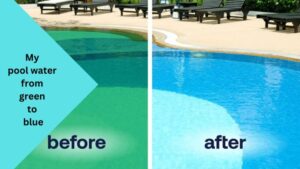Having a sparkling blue swimming pool is the dream of every pool owner. However, seeing your pool water turn green can be a frustrating experience. If you’re wondering how to turn your pool water from green to blue, you’ve come to the right place. In this comprehensive guide, we will walk you through the steps and solutions to transform your pool from a murky green mess into a refreshing oasis.
- Why is Your Pool Water Green?
- How to Clean a Pool from Green to Blue:
- Recommended Chemicals to Make Pool Water Blue:
- Using Green to Blue Liquid: An Effective Solution
- Maintaining Crystal Clear Blue Pool Water:
- Regular Cleaning and Maintenance:
- Proper Filtration and Circulation:
- Regular Water Testing and Chemical Balancing:
- Conclusion:
Why is Your Pool Water Green?
Before we dive into the solutions, it’s important to understand why your pool water turns green in the first place. Typically, the green color is a result of algae growth. Algae thrive in warm, stagnant water and can multiply rapidly if left untreated. Factors such as imbalanced pH levels, insufficient chlorine, poor filtration, and lack of regular maintenance contribute to the growth of algae and the discoloration of your pool water. Here is A Complete Guide to Eradicate Mustard Algae: Say Goodbye to Pool Troubles
How to Clean a Pool from Green to Blue:

Transforming your pool water from green to blue involves a step-by-step process that focuses on eliminating algae and restoring the balance of your pool chemistry. Follow these steps to revive your pool and achieve crystal clear blue water:
Step 1: Test and Adjust the pH Level
To begin the cleaning process, test the pH level of your pool water using a reliable test kit. The ideal range for pH is between 7.2 and 7.6. If the pH level is too high, add a pH decrease to bring it within the recommended range. Conversely, if the pH level is too low, use a pH increase to raise it appropriately. Balancing the pH is crucial as it ensures the effectiveness of subsequent treatments.
Step 2: Remove Debris and Algae
Before treating the pool, it’s essential to skim the surface and remove any visible debris using a pool net. Clearing the pool of leaves, twigs, and other debris helps improve the effectiveness of the treatment process. Once the surface is clear, brush the walls and floor of the pool with a pool brush to dislodge any algae clinging to the surfaces.
Step 3: Shock Treatment
Shocking the pool involves adding a high dosage of chlorine to kill existing algae and remove other organic contaminants. Calculate the amount of shock treatment required based on the size of your pool and the manufacturer’s instructions. Carefully follow the instructions and distribute the shock treatment evenly across the pool. Allow the pool pump to run continuously for at least 24 hours to aid in oxidation and filtration.
Step 4: Chlorinate the Pool
After the shock treatment, it’s time to add a stabilizing level of chlorine to your pool. Ensure the chlorine levels are maintained between 1 and 3 parts per million (ppm) to prevent future algae growth. Use chlorine tablets or granules and distribute them evenly throughout the pool water. Regularly test the chlorine levels and add more if necessary to keep it within the recommended range.
Step 5: Filtration and Circulation
Proper filtration and circulation are crucial in maintaining clean and clear pool water. Ensure your pool’s filtration system is in good working condition. Run the pool pump and filter continuously for 24 to 48 hours after the shock treatment, and periodically backwash or clean the filter as necessary. Additionally, circulating the water using pool jets and returns helps distribute chemicals evenly and prevent stagnant areas where algae can grow.
Recommended Chemicals to Make Pool Water Blue:
Besides the steps mentioned above, using the right pool chemicals is essential to turn your pool water from green to blue. Here are some recommended chemicals that can help in the process:
Chlorine:
Chlorine is a powerful disinfectant that helps kill algae, bacteria, and other contaminants in your pool water. Regularly maintaining chlorine levels within the recommended range is critical for a healthy and blue pool.
Algaecide:
Algaecides are designed to prevent and control algae growth. Choose an algaecide that is suited for your specific type of algae, and follow the manufacturer’s instructions for effective use.
pH Control Agents:
pH control agents such as pH increases and decreases allow you to maintain the ideal pH level in your pool water. They help optimize the effectiveness of other chemicals and prevent algae growth.
Clarifiers:
Clarifiers help clear up cloudy or hazy water by coagulating tiny particles and making them easier to filter out. Regular use of clarifiers can enhance water clarity and prevent future algae growth.
Using Green to Blue Liquid: An Effective Solution
If you’re looking for a convenient and effective solution to turn your pool water from green to blue, green to blue liquid products are worth considering. These specialized formulas contain a combination of chemicals designed to treat algae and restore water clarity. Follow the instructions provided by the manufacturer to effectively use the green to blue liquid and witness your pool water transform before your eyes.
Maintaining Crystal Clear Blue Pool Water:
Once you’ve successfully turned your pool water from green to blue, it’s crucial to maintain proper pool care and prevent future algae growth. Here are some tips to keep your pool water crystal clear:
Regular Cleaning and Maintenance:
Maintain a regular cleaning schedule to prevent debris buildup, and regularly skim the surface to remove any floating particles. Brush the pool walls and floor weekly to prevent algae from adhering to the surfaces. You should also know about Cost of Cleaning Your Swimming Pool – DIY vs. Hiring a Pro
Proper Filtration and Circulation:
Ensure your pool’s filtration system is functioning properly, and clean or backwash the filter as needed. Run the pool pump and filter for the recommended amount of time each day to maintain proper water circulation and filtration.
Regular Water Testing and Chemical Balancing:
Test your pool water regularly using a reliable test kit to monitor pH, chlorine levels, and other important parameters. Balance the pool chemicals as needed to keep the water chemistry within the recommended ranges.
Related post for you: Stonescapes Tropics Blue vs Aqua Blue
Conclusion:
Turning your pool water from green to blue may seem like a daunting task, but with the right steps and proper maintenance, it can be easily achieved. By addressing the root causes of algae growth, utilizing the recommended chemicals, and maintaining regular pool care, you can enjoy a crystal clear blue pool that is inviting and refreshing. Remember to follow the outlined steps, stay consistent with maintenance, and regularly test and balance your pool water chemistry. So, dive into your rejuvenated pool and savor the joy of sparkling blue water all summer long.

Greetings, fellow pool enthusiasts! I’m Turner Davis, your dedicated guide to the world of pool care and maintenance. With over a decade of experience in the field, I’ve made it my mission to transform ordinary pools into extraordinary aquatic retreats.

